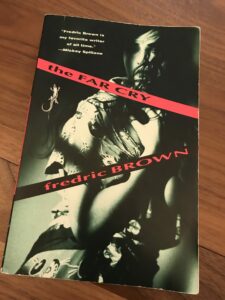Summary:
In a lonely cabin near Taos, a girl named Jenny Ames was murdered. No one knew who she was, how she died, or who killed her. Eight years later, George Weaver moved into the cabin to recuperate after a psychological breakdown caused by overwork. Incapable of letting things rest, Weaver begins investigating the murder as a way of passing the time, but his investigation will answer questions he didn’t anticipate. The Far Cry is a fast-paced novel of suspense, a slow-burn portrayal of a psychological meltdown, and an existential allegory.
Analysis:
Mid-century noir writers such as Frederic Brown, David Goodis, Jim Thompson, and James M. Cain excelled at blending mystery and suspense by depicting modern man struggling within the confines of modern life. In their writing, crime became a metaphor for humanity’s psychological struggle with repression. In certain ways and in some instances, crime reveals itself to be an active expression of an individual’s need to transcend the confines of their society, their situation, or their choices. Of course, that doesn’t account for all crime or all crime fiction, but it’s the paradigm for many great mid-century noir novels, and Brown’s The Far Cry reverses the paradigm, making the solution to crime an allegory for the realization of an existential crisis.
George Weaver had overworked and wound up in a sanitorium. He comes to Taos to “paint pictures or write poetry or something, for the summer” (7). Isolated from everyday life, Weaver investigates the murder of Jenny Ames, which occurred in Weaver’s cabin. Weaver’s wife joins him, and the two grate on one another in the small space. Weaver’s drive to work becomes the drive to solve the murder, an inexorable drive that pushes him into a frenzy, the same frenzy that led to the breakdown that brought him to the cabin. Weaver pursues truth as a form of distraction from the reality of his existence, as though the solution to his personal problems could be found in the resolution of someone else’s past.
Weaver must face his personal connection to the past and resolve the tensions in his life that brought him to that particular cabin in those particular woods. Ultimately, he must face the cause of his neuroses.
Brown’s prose is tight and crisp, and his story moves quickly without losing any tension. His use of mystery as a philosophical pressure cooker makes the novel well worth reading. Brown spreads a yarn, ties it in a knot, and we, the reader, pull one end to tug it loose. The unraveled escapade falls in our lap, and we need a minute to see what we have and to remember all the steps it took to get there.
Biography:
Frederic Brown (1906-1972) wrote science fiction and mystery. The Fabulous Clipjoint won the Edgar Award for best first novel.





